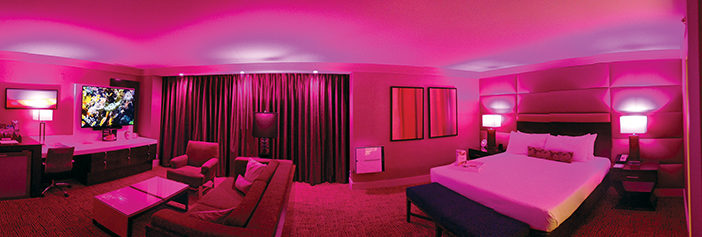AUSTIN, TX—Lighting isn’t the first thing properties consider when determining ways to enhance health and wellness experiences for guests, but maybe it should be—especially when there’s a “natural” solution available to properties across the map.
“We started off with the idea of trying to understand why making LED lighting that actually looked good was so hard,” said Rebecca Frank, director of software and firmware engineering for Ketra Inc. “You want to have multicolored sources (red, green, blue and white) to have good color rendering, which makes colors look richer and more saturated, but that turns out to be really hard with LEDs. There’s a lot of variation from one LED to the next due to the manufacturing process.”
Horace Ho, David Knapp and Jason Lewis founded the lighting company in 2009. The problem at the time was there were some issues with LED lighting. For example, these products typically didn’t dim well. Ketra designed new technology in response to that, and has been evolving its vision of providing better lighting ever since the company’s launch.
“Each LED’s individual output changes with temperature and as it ages,” Frank explained. “If you have a red LED and a white LED and the white one ages faster, then you’ve got a light that’s shifting color as it ages, so we set out to make a custom driver chip that addresses all of that. This meant taking technology our team knew from the mixed-signal semiconductor industry and applying it to lighting. It takes measurements 360 times a second, faster than we can see, monitoring the light output and temperature and making adjustments accordingly so that the color stays consistent.”
Ketra’s team quickly realized at the time that the company’s chip wasn’t the only challenge to creating high-quality light. “We needed to make narrow beam angles that still have uniform color, which means designing our own custom emitter,” she said. “We also build our own software and robotics for calibrating each light before it ships out from our factory.” The next step in the process for them became the focus on control.
“Our products are connected via our own wireless mesh network, which means that each device can relay messages to other devices,” Frank explained. “Because we make the lights and the controls, we have the unique positioning to be able to integrate the two systems and make them work together seamlessly.”
Nav Sooch, who’s been the natural lighting company’s CEO since October 2011, said, “We want to create really amazing experiences through light, and what [Ketra’s] technology allows us to do is to create spaces that are really enjoyable and healthier from an occupant’s perspective.”
Ketra’s lighting system mimics the color temperature and intensity of natural light. Its LEDs shift throughout the day in an attempt to provide the full range of sunlight—crisp and bright during the day, soft and warm at night. “Essentially, inside each light source is multicolored lighting,” he explained. “You don’t see the individual colors, but they blend together. It’s really red, green, blue and white all combined together. By changing the amount of each of those colors, we can create this infinite range of hues.”
The results of a survey commissioned by Ketra and conducted by Harris Poll, a Rochester, NY-based market research company, revealed that 89% of Americans believe exposure to natural light has a major/moderate impact on mood, while 87% say exposure to natural light has a positive impact on productivity, alertness and brain function. Additionally, 79% of the survey’s respondents said they wish they were able to spend more time outdoors during the day to get more exposure to natural light.
“When we started thinking about how to really use the technology in our chip, we kept coming back to how our activities, our bodily rhythms, and the ways we interact with a space all change based on the time of day,” Frank said. “The original, ideal light source—the sun—is, of course, dynamic with the time of day, too. We want bright, cool light that helps us focus during the day, and a warm, cozy glow that helps us wind down at night.”
Ketra’s technology doesn’t produce natural light exactly. “In the visible light spectrum, it’s a very good approximation for it,” Sooch said. For instance, there’s no UV in the company’s LED lights, “so you’re not going to get a sun tan under our light,” he joked; however, Ketra’s lighting systems are, in fact, made up of wavelengths known to cause physiological reactions to the human body, he added.
The global lighting market is expected to grow at a CAGR of 9.22% between 2017-2021, according to Dublin-based Research and Markets, a market research firm. One of the major drivers for this market is LED, which continues to be the future of lighting, analysts said. The total LED lighting market is expected to be valued at $92.4 billion by 2022.
Both Ketra and its natural lighting are still in their infancy. “We’ve only been marketing our products for a couple of years,” Sooch said. “We’re small, but we’re the largest player in this natural light category. We’re quite confident that this natural light category will become a dominant category over the next year. We intend to continue to lead this category.” What separates Ketra from its competitors is it uses the highest quality of light, he said.
“Our light system is the most complete,” Sooch explained. “We have light fixtures that are all the right form factors that you’d want to use in a variety of spaces from office to hospitality to residential. We have a complete line of controls—including keypads that can be wall-mounted and mobile apps that allow you to control the lighting.”
Ketra’s technology can integrate with automation systems, as well as shading solutions, audiovisual systems and occupancy sensors. “It’s really a complete solution—we do lighting and controls—as opposed to a lot of these competitive offerings [providing]one or the other,” he said. “It’s a mess for a project that’s trying to integrate all of this together.” Ketra’s lighting system attempts to limit the number of extra meetings with contractors and mechanical engineering plumbing (MEP) firms. “Projects just don’t get executed properly when there’s many vendors involved, but at Ketra, we really simplify that installation and construction process,” Sooch noted.
Ketra’s top three target markets are high-end office spaces, high-end hospitality spaces and high-end residential spaces. “We’re going to continue to market in all three of those categories,” Sooch said. “This is just a tremendously exciting time for our company.” The lighting company’s technology can be found in a variety of commercial spaces with brands including Google, Pinterest, Whole Foods Market and more. Ketra has also penetrated the hospitality market; however, the CEO didn’t have an exact percentage.
Ketra’s lighting technology can be found in the Stay Well Mirage Suites at The Mirage in Las Vegas. The lighting company retrofitted these rooms, “so they actually have standard cans, and we put Ketra light bulbs inside those cans,” he said. “Then there’s a control box in each one of those rooms that gives the user several different choices of lighting.” Numerous Marriott properties also have partnered with Ketra on lighting. “We’re working on several others I can’t speak about at the moment,” Ketra’s CEO explained.
Costs in lighting today aren’t in the lamp (Ketra’s standard bulb costs $100); it’s in the light fixtures and the lighting control systems. “You can do a really nice hotel room for anywhere from $2,000 for the room up to about $5,000, depending on how big the room is and how much lighting and what quality fixtures you choose,” he said, pointing out how projects focus on the quality of the overall design—not just a bulb. “I think the light bulb makes sense when you have a table lamp, and you want to put the light source inside a decorative layer, but the vast majority of lighting is actually built into the space.” For instance, Ketra’s portfolio also includes downlights, cove lights and linear pendants.
Oftentimes, special lighting is used for events, but Ketra pitches its lighting as an alternative. “With our systems, you don’t have to bring in anything special,” he said about the systems. “You just press a button, and you can create a special event.”
Ketra isn’t targeting a particular chain scale. While its CEO admits “more progressive hotels are the early adopters,” nothing is off the table. “I think their desire to put it in every room is going to gradually and suddenly increase, so I think we are the perfect solution because the price points we can achieve are suitable for across the board.
“We’re growing really rapidly,” Sooch continued. “Sales are at least tripling for last year to this year, and we really don’t see any end in sight as the category itself continues to grow.” HB


